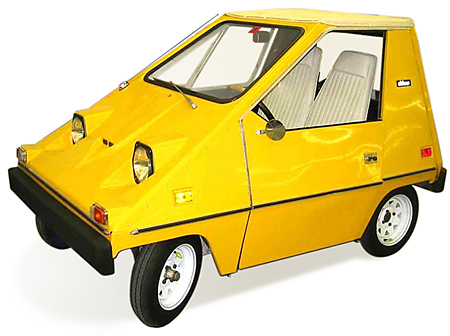
In the late 70s, my grandfather, Ralph Grayson, accepted an assignment from NASA, that required him to relocate to California for a few years (Principle Research Scientist, Aviation Safety Reporting, under a Battelle research contract).
This was amidst the Opec Oil embargo, and the infamous California gasoline rationing. Ralph bought himself an electric car. More specifically, he bought a Serbring Vanguard, Electric CitiCar. Not content to use it for corner store runs, he made it his daily driver to the NASA facility at the Moffett Field Naval Air Station in Mountain View (this U.S. Naval Base was closed in 1992).
Truthfully, taking the CitiCar out on the highway was like riding in the Kevorkian death-trap. The body was made out of plastic. Can I say that again? Plastic. The earliest models had no front bumper at all. Each subsequent model had a larger and larger bumper, until the final models produced had a big bizarre looking snout. I remember running out of charge once, stuck in traffic on the highway and helping my grandfather push the thing to the nearest “gas station” so he could plug it in to their electrical outlet.
I still loved that car. It was fun to ride around in. It was only supposed to go 30 mph, but he souped it up, and was able to eek 40mph+ out of it. It made hardly any sound, just a muffled high-pitched whir. Because it was electric it really only had two speeds: stop and go. The acceleration was so swift it gave the feeling you were going much faster than you were. It could beat any sports car off the line. It was quite entertaining to see this awkward, doorstop-wedge of a vehicle leave corvettes behind, even more so when you were the one riding in it. I also loved that car because it meant something symbolic. It was a glimpse into one possible future. An optimistic one, where necessity was the mother of invention.
Gasoline and the Combustible Engine
The problem with gasoline is not that it’s too expensive, but to the contrary, that it’s far too cheap. Capital investment, real investment, won’t flood into so called “alternative energy sources” until they become cost-competitive with oil. The path to alternative energy is expensive oil. Nobody wants expensive oil because of the high investment we’ve all made in the internal combustion engine. Not just automobile manufacturers, or oil companies, but each one of us. For most Americans, their gasoline powered cars are their second largest personal investment after their home. For those who are not home owners, it’s their largest financial investment.
The other dilemma is the investment of man hours. The number of hours that scientist, engineers, inventors, and mechanics have spent for more than a century now refining the internal combustion engine is nearly incalculable. The gasoline powered automobile is a mature technology. That is difficult to compete with, even by a superior technology.
Third time’s a charm?
The 90s saw the short lived GM EV1 get murdered in its infancy by its own parent.
Today we have Tesla Motors, and their sporty Tesla Roadster, body built from technology borrowed from the light weight Lotus Elise. I’m hoping this time they can buck the odds.
For your viewing pleasure.
| The Unveiling of the Tesla Motors Electric Car |
Keio University Japanese electric concept car, Eliica. |
|
| 1996 Commercial for the GM EV1 Electric Car |
Movie Trailer for Who Killed The Electric Car? |
|

To this day, at just over 2500 units sold, the Serbring Vanguard Electric CitiCar still remains the highest production run, street legal electric car ever produced.